Experiment 7: Conductance of Solutions
advertisement
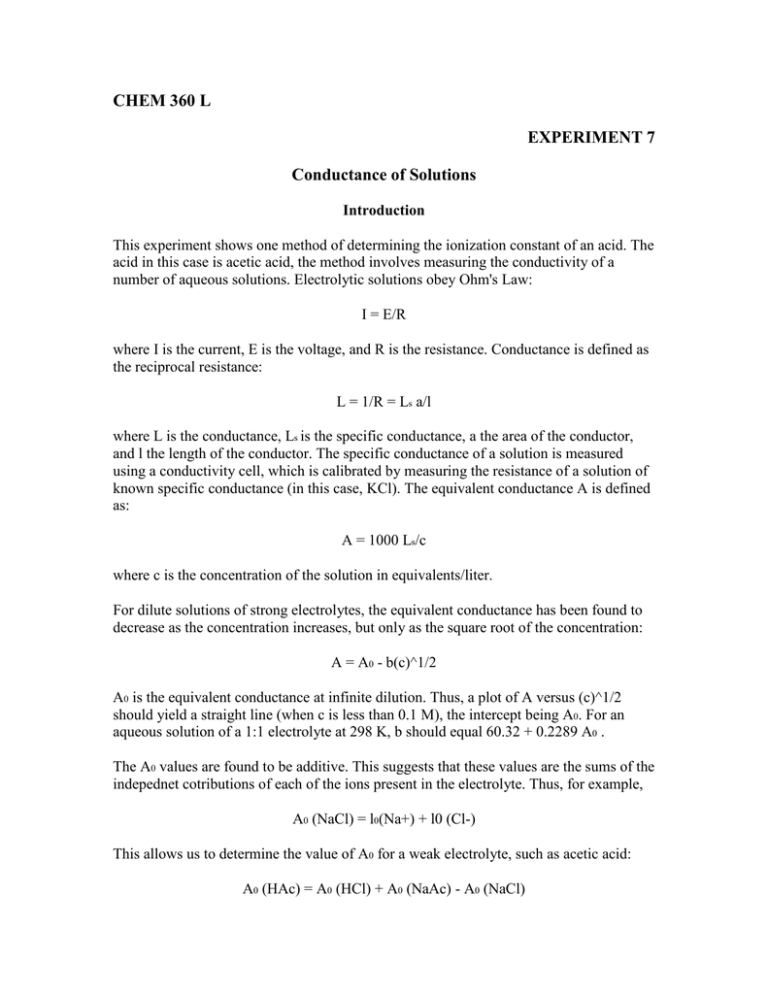
CHEM 360 L EXPERIMENT 7 Conductance of Solutions Introduction This experiment shows one method of determining the ionization constant of an acid. The acid in this case is acetic acid, the method involves measuring the conductivity of a number of aqueous solutions. Electrolytic solutions obey Ohm's Law: I = E/R where I is the current, E is the voltage, and R is the resistance. Conductance is defined as the reciprocal resistance: L = 1/R = Ls a/l where L is the conductance, Ls is the specific conductance, a the area of the conductor, and l the length of the conductor. The specific conductance of a solution is measured using a conductivity cell, which is calibrated by measuring the resistance of a solution of known specific conductance (in this case, KCl). The equivalent conductance A is defined as: A = 1000 Ls/c where c is the concentration of the solution in equivalents/liter. For dilute solutions of strong electrolytes, the equivalent conductance has been found to decrease as the concentration increases, but only as the square root of the concentration: A = A0 - b(c)^1/2 A0 is the equivalent conductance at infinite dilution. Thus, a plot of A versus (c)^1/2 should yield a straight line (when c is less than 0.1 M), the intercept being A0. For an aqueous solution of a 1:1 electrolyte at 298 K, b should equal 60.32 + 0.2289 A0 . The A0 values are found to be additive. This suggests that these values are the sums of the indepednet cotributions of each of the ions present in the electrolyte. Thus, for example, A0 (NaCl) = l0(Na+) + l0 (Cl-) This allows us to determine the value of A0 for a weak electrolyte, such as acetic acid: A0 (HAc) = A0 (HCl) + A0 (NaAc) - A0 (NaCl) The degree of dissociation a of such a weak electrolyte may be expressed as: a =A/A0 The concentration-based equilibrium constant may be expressed in terms of the degree of dissociation: Kc = [H+][Ac-]/[HAc] = ca^2/(1-a) and this may be used to obtain the thermodynamic equilibrium constant, K: K = [H+][Ac-]y+y-/[HAc]ya where y+, y- , and ya are the activity coefficients for H+, Ac-, and HAc, respectively. The activity coefficients may be estimated using the Debye-Huckel limiting law: log y+ = -0.5091 Z+Z- (ca)^1/2 for a 1:1 weak electrolyte where y+ is the mean ionic activity coefficient (y+y-)^1/2, the Z 's are the ionic charges, and the c's the ionic concentrations. The logarithmic version of equation (9) becomes: log Kc = log K - log y+ since ya may be assumed to be unity. A plot of log Kc versus (ca)^1/2 should yield a straight line of slope 1.018 and an intercept of log K. Procedure Rinse the conductivity cell several times with distilled water. Prepare a solution of 0.0100 M KCl (it does not have to be exactly 0.0100 M, but you should know the concentration to that level of precision) and measure its resistance. Since there is some slip to the variable resistance in the bridge, you should measure each solution's resistance four times, twice from below and twice from above. Solutions of 0.10 , 0.05. 0.025, 0.0125, and 0.00625 M HCl, NaCl, and NaAc should be prepared, with their resistances measured in a similar fashion. Acetic acid solutions should be prepared at the concentrations, also at concentrations of 0.00312 and 0.00156 M. All resistance measurements should be made while the cell is immersed in a 25oC water bath. Calculations Determine the cell constant from the resistance of the KCl solution (Ls for 0.0100 M KCl is 0.001412 ohm-1 cm-1). Determine the equivalent conductances for each of the strong electrolyte solutions, then plot them versus (c)^1/2. You may include all three such plots on the same graph. From the linear regressions, determine the value of A0 for each of these solutions. From the A0 values, determine the value of A0 for acetic acid. Calculate Kc for each concentration, then plot the Kc values versus (ca)^1/2. Find the value of K from this graph (a linear regression may be warranted, but make sure that the regression uses only the linear portion of the graph). Report the standard errors in the A0 values, and estimate the error in the value of K.
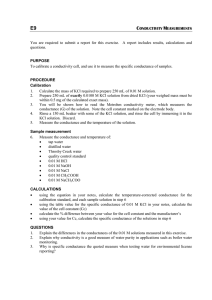
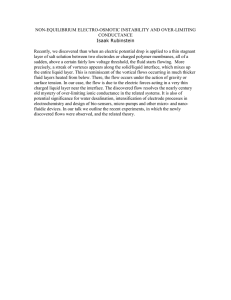



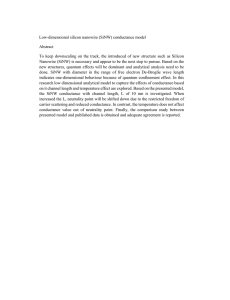
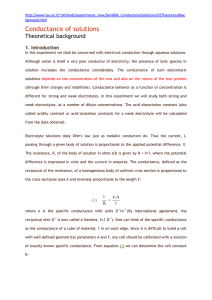


![Electrokinetics : [pt.] III.-surface conductance and the](http://s2.studylib.net/store/data/018742539_1-f7ef04f84e7d8bbdddc9ccd4b52642fa-300x300.png)